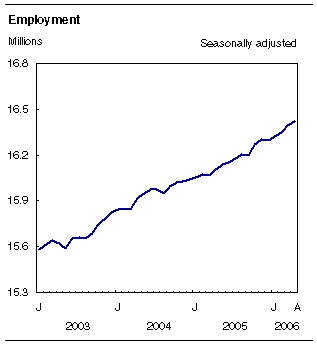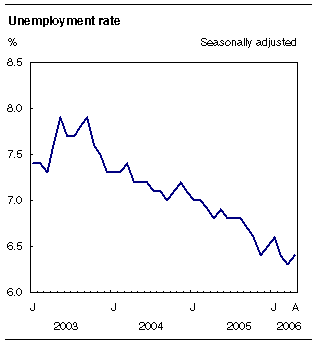
















 |
|
 |                |
Information identified as archived is provided for reference, research or recordkeeping purposes. It is not subject to the Government of Canada Web Standards and has not been altered or updated since it was archived. Please "contact us" to request a format other than those available.

|

Friday, May 5, 2006 Labour Force Survey
Employment rose by an estimated 22,000 in April. At the same time, the unemployment rate edged up to 6.4% (+0.1 percentage points), still hovering around a 30-year low. So far in 2006, employment is up 124,000 or 0.8%, double the pace of growth observed over the first four months of last year. The employment gain in April was the result of an increase in full-time work (+26,000). This continues the long-term trend of full-time growth. Part-time employment has remained around the same level over the last three years. 
With an employment increase of 39,000 in April, the share of adult women who were employed hit a record high of 58.0%. At 2.2%, the pace of growth for this group over the last 12 months is now well in excess of that for adult men.
After peaking at 61.4% nearly two years ago, the labour force participation rate for adult women began a slow decline. However, with recent strength in employment, the participation rate among these women is again near its record high. With strong full-time employment growth over the last year and an unemployment rate perched around its record low, wages continue to rise. The average hourly wage in April was up 3.1% from 12 months ago, compared to the most recent 2.2% increase in the Consumer Price Index. Hourly wage rate growth continues to be highest in Alberta's tight labour market (+6.8%). For the second consecutive month, the bulk of the employment gains were in Ontario. In Canada's two westernmost provinces, there was a pause in the strong pace of employment growth that has been observed for some time. However, over the first four months of 2006, employment growth in Alberta was well ahead of the rest of the country. 
Employment continues to rise in OntarioEmployment in Ontario continued to pick up in April with an increase of 24,000, mostly among adult women. A settlement of the labour dispute affecting Ontario colleges may have contributed to a decline in youth employment. As classes resumed, this may have left less time for college students to work at a paid job in April. The recent employment growth in Ontario brings increases over the last 12 months to 108,000 (+1.7%). Over this period, increases in several service-based industries such as business, building and other support services (+34,000); educational services (+30,000); as well as retail and wholesale trade (+23,000) have more than offset losses in manufacturing (-56,000). There has also been strength in construction with 31,000 more workers in the industry compared to 12 months ago. The Atlantic provinces also benefited from employment gains in April, with more people working in both Newfoundland and Labrador (+3,000) and Prince Edward Island (+2,000). Despite more employment in Newfoundland and Labrador, the unemployment rate edged up 0.2 percentage points to 15.9% as more people entered the labour force. In Prince Edward Island, the increase in employment pushed the unemployment rate for the province down to 10.5% (-1.5 percentage points). On the heels of a strong increase in gross domestic product in 2005, employment in Saskatchewan was up 5,000 in April. This brings employment growth since the start of the year to 1.7%, driven by increases in construction, retail and wholesale trade and a resurgent natural resources sector. The employment gains in April pushed the unemployment rate down 0.5 percentage points to 4.8%. In Manitoba, employment increased by 4,000 in April, bringing total gains from 12 months ago to 11,000 (+1.9%). Despite more employment in April, the unemployment rate rose by 0.5 percentage points to 4.7% as more people entered the labour force in search of work. Over the past 12 months, the largest employment increases have been in retail and wholesale trade; finance, insurance, real estate and leasing, as well as construction. Despite little change in April, employment growth in Alberta and British Columbia has outpaced the rest of the country over the last 12 months. In Alberta, the rising price of oil over the past year has caused employment to go up in the oil patch as well as in professional, scientific and technical services. In British Columbia, strength over the same period has come from retail and wholesale trade; information, culture and recreation as well as transportation and warehousing. With these strong employment gains, their respective unemployment rates remained lower in April than in any other province (3.5% in Alberta and 4.5% in British Columbia). In Quebec, employment fell by an estimated 24,000 in April. This is the first significant decline so far in 2006 and leaves growth since last May, when employment began to pick up, at 1.6% or 60,000. In spite of the decline in employment, the unemployment rate fell 0.2 percentage points to 8.3%, the result of a decline in the number of youths in the labour force. Adult women gain momentumSo far in 2006, employment growth among adult women aged 25 and over has been brisk, increasing by 39,000 in April and by 94,000 or 1.5% since the start of the year. This contrasts with the weak 0.2% employment growth among adult men since the start of the year. As a result of the recent employment strength among adult women, their unemployment rate now stands at 5.3%, slightly below the rate for adult men. Despite a decline of 29,000 in April, employment among youths aged 15 to 24 has grown by 71,000 since last September. The youth unemployment rate remained at 11.5% in April as fewer youths were in the labour force, keeping the rate among the lowest in 15 years. Employment up in manufacturing and tradeEmployment in manufacturing rose by an estimated 25,000 in April. Despite this gain, losses since the end of 2002 have totalled 165,000 or 7.1%. Although there are fewer workers, factory output has shown an upward trend over the corresponding period. Furthermore, the recent decline in manufacturing employment pales in comparison to the recession of the early 1990s when employment fell much more sharply over the same span of time, down 329,000 or 15.5%. Employment in retail and wholesale trade continued its upward trend with an increase of 20,000 in April, bringing gains over the past 12 months to 105,000 (+4.1%). Strength over the last year has been most pronounced in British Columbia with notable growth also in Quebec and Ontario. Transportation and warehousing (-15,000) was the only industry with a significant employment decline in April. This offsets a similar increase the month before and leaves employment in the industry 20,000 (+2.6%) above the level from 12 months ago. Available on CANSIM: tables 282-0001 to 282-0042, 282-0047 to 282-0064 and 282-0069 to 282-0099. Definitions, data sources and methods: survey number 3701. Available at 7:00 a.m. on our Web site. From the home page, choose Today's news releases from The Daily, then Latest Labour Force Survey. A more detailed summary, Labour Force Information, is available today for the week ending April 15 (71-001-XIE, free). To obtain a copy, go to the Our products and services page of our Web site. LAN and bulk prices are available on request. The 2005 Labour Force Historical Review on CD-ROM (71F0004XCB, $209) is now available. LAN and bulk prices are available on request. Data tables are also available in the Canadian Statistics module of our website. The next release of the Labour Force Survey will be on Friday, June 9. For general information or to order data, contact Client Services (1-866-873-8788; 613-951-4090; labour@statcan.gc.ca). To enquire about the concepts, methods or data quality of this release, contact Vincent Ferrao (613-951-4750) or Danielle Zietsma (613-951-4243), Labour Statistics Division.
| |||||||||||||||||||||||||||||||||||||||||||||||||||||||||||||||||||||||||||||||||||||||||||||||||||||||||||||||||||||||||||||||||||||||||||||||||||||||||||||||||||||||||||||||||||||||||||||||||||||||||||||||||||||||||||||||||||||||||||||||||||||||||||||||||||||||||||||||||||||||||||||||||||||||||||||||||||||||||||||||||||||||||||||||||||||||||||||||||||||||||||||||||||||||||||||||||||||||||||||||||||||||||||||||||||||||||||||||||||||||||||||||||||||||||||||||||||||||||||||||||||||||||||||||||||||||||||||||||||||||||||||||||||||||||||||||||||||||||||||||||||||||||||||||||||||||||||||||||||||||||||||||||||||||||||||||||||||||||||||||||||
|
|
|